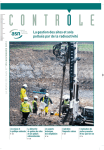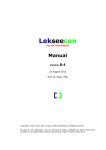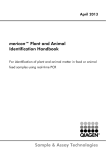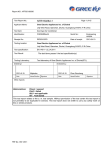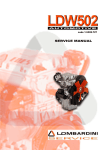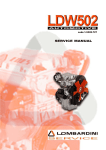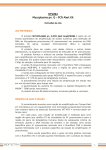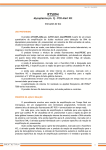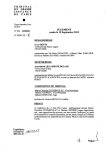Download quanty enterovirus (5`UTR region)
Transcript
quanty enterovirus (5’UTR region) REF: RT-33 Detection and quantification of the Enterovirus genome with Real Time PCR INTRODUCTION AND PURPOSE OF USE The quanty enterovirus system is a quantitative test that allows the RNA amplification and quantification, by means of Real Time PCR, of 5’UTR region of Enterovirus RNA. The Procedure allows the detection of the RNA target by means a retro-amplification reaction. The analysis of the results is made using a Real Time PCR analyzer (thermal cycler integrated with a system for fluorescence detection and a dedicated software). CONTENT The kit contains reagents enough to perform 48 amplification tests Quantity R1 3 x 10 µl Description Enzyme mMix Reverse Transcriptase e Taq Polymerase enzymes (Blue Cap) Enterovirus probe Mix Upstream primer, downstream primer, Target probe (FAM), Internal Control (IC) probe (VIC), Nuclease-free water, dNTPs, Tris-HCl, KCl, MgCl2 (Green Cap) R2 3 x 270 µl R3 3 x 35 µl R4 3 x 35 µl R5 3 x 35 µl synthetic RNA corresponding to 5’UTR gene 100.000 cps/µl synthetic RNA corresponding to 5’UTR gene 10.000 cps/µl synthetic RNA corresponding to 5’UTR gene 10.000 cps/µl R6 3 x 35 µl synthetic RNA corresponding to 5’UTR gene 100 cps/µl R7 1 x 30 µl Negative Control (Yellow Cap) Instruction for use: ST. RT33-ENG.1 MATERIALS AND STRUMENTATION REQUIRED BUT NOT SUPPLIED Disposable latex powder-free gloves or similar material; Bench microcentrifuge (12,000 - 14,000 rpm); Micropipettes and Sterile tips with aerosol filter; Vortex; Plastic materials (microplate and optica adesive cover); Heat block (only for extraction) Reagents The quanty enterovirus kit was developed and validated to be used with the following extraction method: Manual Extraction EX16 – Viral RNA extraction from plasma, serum, urine or swab. The kit allows the manual RNA extraction from Human samples. The kit contains reagents enough to perform the DNA extraction for 50 samples. (Clonit srl) Real Time PCR The quanty enterovirus kit was developed and validated to be used with the following real time PCR instruments: • 7500 Fast (Lifetechnologies) • Stratagene MX3000P (Agilent Technologies) • Rotor-Gene Q 5/6 plex (QIAGEN) • CFX96 Real Time PCR System (BioRad) Please ensure that the instruments have been installed, calibrated, checked and maintained according to the manufacturer’s instruction and raccommendations. SAMPLES AND STORAGE The quanty enterovirus system must be used with extracted RNA from the following biological samples: Serum and Urine. Collected material must be shipped and stored at +2 - +8°C. Store the samples at -20°C if not used within 3 days. PRECAUTIONS USE This kit is for in vitro diagnostic (IVD), for professional use only and not for in vivo use. After reconstitution, the amplification master mix must be used in one time (16 reactions). Repeat thawing and freezing of reagents (more than twice) should be avoided, as this might affect the performance of the assay. The reagents should be frozen in aliquots, if they are to be used intermittently. At all times follow Good Laboratory Practice (GLP) guidelines. Wear protective clothing such as laboratory coats and disposable gloves while assaying samples. Avoid any contact between hands and eyes or nose during specimens collection and testing. Handle and dispose all used materials into appropriate bio-hazard waste containers. It should be discarded according to local law. Keep separated the extraction and the reagents preparation. Never pipette solutions by mouth. Avoid the air bubbles during the master mix dispensing. Eliminate them before starting amplification. Wash hands carefully after handling samples and reagents. Do not mix reagents from different lots. It is not infectious and hazardous for the health (see Material Safety data Sheet – MSDS). Do not eat, drink or smoke in the area where specimens and kit reagents are handled. Read carefully the instructions notice before using this test. Do not use beyond the expiration date which appears on the package label. Do not use a test from a damaged protective wrapper. 7. 8. 9. 10. 11. LIMIT OF THE METHOD The extreme sensitivity of gene amplification may cause false positives due to cross-contamination between samples and controls. Therefore, you should: physically separate all the products and reagents used for amplification reactions from those used for other reactions, as well as from post-amplification products; use tips with filters to prevent cross-contamination between samples; use disposable gloves and change them frequently; carefully open test tubes to prevent aerosol formation; close every test tube before opening another one. The proper functioning of the amplification mix depends on the correct collection, correct transportation, correct storage and correct preparation of a biological sample. As with any diagnostic device, the results obtained with this product must be interpreted taking in consideration all the clinical data and other laboratory tests done on the patient. A negative result obtained with this product suggests that the RNA of Enterovirus was not detected in RNA extracted from the sample, but it may also contain Enterovirus-RNA at a lower titre than the detection limit for the product (detection limit for the product, see paragraph on Performance Characteristics); in this case the result would be a false negative. As with any diagnostic device, with this product there is a residual risk of obtaining invalid, false positives or false negatives results. STORAGE AND STABILITY Store the product quanty enterovirus at –20°C. The quanty enterovirus kit is shipped on dry ice. The kit components should be frozen. An intact and well stored product has a stability of 6 months from the date of production. Do not use beyond the expiration date which appears on the package label. Repeat thawing and freezing of reagents (more than twice) should be avoided, as this might affect the performance of the assay. The reagents should be frozen in aliquots, if they are to be used intermittently. ANALYTICAL PROCEDURE Extraction of Enterovirus-RNA Manual Extraction EX16 – Viral RNA extraction from plasma, serum, urine or swab. 1. add 310 •l buffer AVE to the tube containing 310 •g lyophilized carrier RNA. Dissolve the carrier RNA thoroughly, divide it into conveniently sized aliquots, and store it at –20°C. Do not freeze–thaw the aliquots of carrier RNA more than 3 times. 2. check buffer AVL for precipitate, and if necessary incubate at 80°C until the precipitate is dissolved. Calculate the volume of buffer AVL–carrier RNA mix needed per batch of samples: n x 0.56 ml = y ml y ml x 10 •l/ml = z •l where: n = number of samples to be processed simultaneously y = calculated volume of Buffer AVL z = volume of carrier RNA–Buffer AVE to add to Buffer AVL Gently mix by inverting the tube 10 times. To avoid foaming, do not vortex. Buffer AVL–carrier RNA should be prepared fresh, and is stable at 2–8°C for up to 48 hours. This solution develops a precipitate when stored at 2–8°C that must be redissolved by warming at 80°C before use. Do not warm Buffer AVL–carrier RNA solution more than 6 times. Do not incubate at 80°C for more than 5 minutes. Frequent warming and extended incubation will cause degradation of carrier RNA, leading to reduced recovery of viral RNA and eventually false negative RT-PCR results. This is particularly the case with low-titer samples. 3. 4. 5. 6. pipet 560 •l of prepared buffer AVL-carrier RNA into a 1.5 ml microcentrifuge tube. add 140 •l plasma, serum, urine, or swab liquid carrier to the buffer AVL–carrier RNA in the microcentrifuge tube. Mix by pulse-vortexing for 15 s. incubate at room temperature (15–25°C) for 10 min. briefly centrifuge the tube to remove drops from the inside of the lid. 12. add 560 •l of ethanol 95% to the sample, and mix by pulsevortexing for 15 s. After mixing, briefly centrifuge the tube to remove drops from inside the lid. carefully apply 630 •l of the solution from step 7 to the spin column (in a 2 ml collection tube) without wetting the rim. Close the cap, and centrifuge at 6000 x g (8000 rpm) for 1 min. Place the QIAamp Mini column into a clean 2 ml collection tube, and discard the tube containing the filtrate. carefully open the spin column, and repeat step 8. carefully open the spin column, and add 500 •l of buffer AW1. Close the cap, and centrifuge at 6000 x g (8000 rpm) for 1 min. Place the spin column in a clean 2 ml collection tube (provided), and discard the tube containing the filtrate. carefully open the spin column, and add 500 •l of buffer AW2. Close the cap and centrifuge at full speed (20,000 x g; 14,000 rpm) for 3 min. Place the spin column in a new 1,5 ml collection tube (not provided), and discard the old collection tube with the filtrate. add 50 •l of buffer AVE equilibrated to room temperature. Close the cap, and incubate at room temperature for 1 min. Centrifuge at 6000 x g (8000 rpm) for 1 min. In the window “Select Quantity”, set the concentrations of the 4 calibrators, following the instructions indicated in the paragraph Interpretation of the results. Sign the wells correspondent to Negative control. Define the NTC positions in right menu, setting: Well type: NTC Collect Fluorescent Data: FAM/HEX/ROX Reference Dye: ROX Replicate Symbol: None Clicking on every single well, the window “well information” will appear: set NTC as the name. Sign the wells correspondent to the Samples. Define the samples positions in right menu, setting: Well type: UnKnown Collect Fluorescent Data: FAM/HEX/ROX Reference Dye: ROX Replicate Symbol: None Clicking on every single well, the window “well information” will appear: set the name or the code of the sample. It’s possible, indeed, set near the name of fluorescent reporter the name of analyzed targets: Samples are now ready for amplification or storage at -20°C. FAM Enterovirus SOFTWARE SETTING Lifetechnologies 7500 fast Turn the instrument and the computer on and open the control software. Click on “Advance Setup”: by default the sofware will shows the page “experiment properties”. Write in the “experiment name” the file name, choose the type of instrument (7500 o 7500fast), the type of reaction (quantitation standard curve), the type of used reagent (TaqmanReagents) and the reaction time of analysis (Standard ≈ 2 hours to complete a run). Open the page named “page setup” (sheet Define Target and Samples). In the window Define Targets set: Target Enterovirus probe: Internal Control (IC) probe: Reporter FAM VIC Quencer TAMRA TAMRA Set the samples’ name in the window “Define Samples”. In the same page “plate setup” select the sheet “Assign Target and Samples”. On the screen you will see the microplate draft. Select an area of the plate where the controls will be placed: select wells of the plate and set both targets (Enterovirus and IC). Select “Assign target to selected wells” in the blank, the “task Standard (S)” for Enterovirus target and set the controls’ concentration. Choose an area in the plate where negative control will be placed: select “Assign target to selected wells” in the blank, the “task Negative (N)” for the Enterovirus target. Select an area of the plate where samples will be placed: select the wells and set both targets (Enterovirus and IC). Link every well to a sample, through the window “Assign samples to selected wells”. For each sample, select in the blank “Assign targets to selected wells” the “task UnKnown (U)” for the Enterovirus target. Set ROX as passive reference, using it as normalizer of detecting fluorescence. Open “Run Method” (sheet Graphic View) and set the right thermal cycling: cycles 1 1 45 denaturation 50° C 20 min 95°C 2 min 95° C 15 sec annealing extension 58° C 45 sec 72° C 15 sec In the window “Reaction volume plate per well” set a volume of 30 µl. After preparing the plate, and correctly inserting it in the instrument, press the button “Start Run”. STRATAGENE MX3000P Turn the instrument on and wait until both green lamps have fixed light, turn on the computer and start the control software. In the main screen will appear the window “New Experiment Options”: select “Experiment type”: quantitative PCR (Multiple Standard). Turn the lamp on 20 minutes before doing a new experiment. For turning the lamp on, click on the icon of the lamp in the tool bar or select “Lamp On” from the menu “Instruments”. Verify the right setting of the gain of the fluorescent reporters: in the menu of settings, choose: “Instrument” and then “Filter set gain setting“. Reporter FAM HEX ROX Gain 8 4 1 Click on button “setup” in the tool bar and choose “Plate Setup”. Sign the wells corresponding to calibrators. Define the calibrator’s positions in right menu, setting: Well type: Standard Collect Fluorescent Data: FAM/HEX/ROX Reference Dye: ROX Replicate Symbol: None Clicking on every single well, the window “well information” will appear: choose the name of the calibrator. HEX Internal Control In the tool bar choose the sheet “Thermal Profile Setup”, set the correct thermal cycle and reading the fluorescence in the annealing step: cycles 1 1 45 denaturation 50° C 20 min 95°C 2 min 95° C 15 sec annealing extension 58° C 45 sec 72° C 15 sec After preparing the plate and inserting it in the instrument, press the button “Run”, selecting the sheet Thermal profile status and check the correctness of thermal profile. Select the box Turn Lamp Off at the end of execution. Push the button Start: the software will ask you to indicate the name of saved file. The analysis will start. ROTOR-GENE Q The experiments can be set using the Quick Start Wizard or the Advanced Wizard, which appears when the software is started. Select the wizard "Advanced". As a first step, select the model "Two Step Reaction" with a double click in the "New Run". In the next window, select the type of rotor installed on the instrument from the list that appears. Check the "Locking Ring Attached", check the checkbox and then click "Next". Enter the name of the operator and the reaction volume of 30 µl, and then click "Next". In the next window click on "edit profile". Set the following thermal cycle: cycles 1 1 45 denaturation 50° C 20 min 95°C 2 min 95° C 15 sec annealing extension 58° C 45 sec 72° C 15 sec Select the annealing / extension from the thermal profile and click on "Acquiring A to cycling." In the next window, select yellow from the available channels and add it to acquiring channel along with the green channel and click "OK". In the next window click on "OK" and then click "Next". Click on “Edit Gain” button and set the following values for each channel: Reporter Green Yellow Gain 5 5 To begin the course, click on the button "Start Run". You can save the model before you begin your run by clicking on "Save Template". After clicking on the button "Start Run" window appears "Save As". The stroke can be saved in the desired position by the user. Once the run started, the window "Edit Samples" allows you to set the name of samples and controls in the positions in which they were loaded on the instrument. Select the locations where they were positioned the controls of known concentration and designate them as Enterovirus Standard. Clicking on the box next to "Type" correspondent, in the dropdown menu "Samples" you can select the type of sample being analyzed. Select "Standards". Enter the concentrations of the controls. Select the location where you placed the Negative Control and name it as Negative Control. Clicking on the box next to "Type" correspondent, in the dropdown menu "Samples" you can select the type of sample being analyzed. Select "Negative Controls" Select the location of each sample and enter the name or code of the patient. Clicking on the box next to "Type" correspondent, in the dropdown menu "Samples" you can select the type of sample being analyzed. Select "UnKnown" At the end of the operation click "OK" in the "edit samples" and wait until the end of the race for the analysis (see "Interpretation of Results"). CFX96 Real Time PCR Turn the instrument and the computer on and start the control software. In the principal screen will appear the window “Startup wizard”: select “CFX96” and press “ok”. In the next window push “create new” and set the thermal protocol and the reaction volume (30µl): cycles 1 1 45 denaturation 50° C 20 min 95°C 2 min 95° C 15 sec annealing extension 58° C 45 sec 72° C 15 sec Save the protocol and click the next button. The software will open in default the sheet “plate”. Click “create new”, select “Fluorophores button” to choose fluorophores (FAM and VIC). Select the locations where they were positioned the controls of known concentration and choose the “Sample Type” Standards. Click “Load” check boxes to load fluorophores and Type or select Target Name. In the box “laod concentration” set the concentrations of the 4 calibrators, following the instructions indicated in the paragraph Analysis of the results. Select the location where you placed the Negative Control. Choose the “Sample Type” NTC. Click “Load” check boxes to load fluorophores and Type or select Target Name Select the location of each sample and enter the name or code of the patient. Choose the “Sample Type” Unknown. Click “Load” check boxes to load fluorophores and Type or select Target Name Save the plate clicking the next button and start the experiment PREPARATION OF THE REACTIONS: Defrost a tube of Enzyme mMix; Defrost a tube of Enterovirus probes Mix; Mix carefully by vortex 9µl of Enzyme mMix and 260µl of Enterovirus probes Mix (the mix as produced is enough to prepare 16 reactions of amplification: 4 positive controls, 1 negative control and 11 samples). Distribute, in the amplification plate, 15µl of just reconstituted mix in chosen positions as already set on the instrument software. Distribute, in the negative control position, 15 µl of solution taken by the negative control vial. Distribute, in chosen position for each sample, 15 µl of corresponding sample. Distribute, in chosen positions for the positive controls, 15µl of 102 copies/µl, 103 copies/µl, 104 copies/µl and 105 copies/µl. Seal up accurately the plate using an optichal adesive film and verify that there aren’t air bubbles in the mix, to avoid the amplification interferences. For the Rotor-Gene Q, seal each tube with the appropriate cap. The air bubbles presence is not influently; the rotor centrifugal force will allow automatic deletion. Transfer the plate in the instrument and push the button “Start Run”. QUANTITATIVE ANALYSIS Lifetechnologies 7500 Fast, StepOne Plus. At the end of the PCR run, the software automatically opens the "Analysis" window in the "Amplification plot" sheet on the menu on the left. Select the wells corresponding to the positive control, negative control and samples for analysis. Select in the "Option" window inside the "Target" pop-up menu the Enterovirus target. Check the correct setting of the threshold. Select in the "Option" window inside the "Target" pop-up menu the IC Control target. Check the correct setting of the threshold. The analysis of the results is made selecting from the menu in the left the page “Analysis”. From the page “Standard Curve”, maintaining open the sheet “view well plate” in the right side of the software select the wells containing the points of the curve and verify the parameters described in the paragraph “Interpretation of the Results” (coefficient of correlation, slope ecc…). From the page “Amplification Plot” verify the amplification plot for every single sample. Opening the sheet “view well table” in the right side of the software it is possible to verify the data obtained from experiments: Threshold Cycles, emitted fluorescence and the target quantification expressed in copies/reaction or copies/ml, depending on the settings of the calibration curve. Clicking from the menu file and selecting the box export, the window “export properties” will open. Indicate the file name, select the position to save it (Browse) and click on button “Start export”. In this way the software will permit to save a excel file with all the data corresponding to selected experiment. Stratagene MX3000P. Click on button “Analysis” in the toolbar. The software will open in default the sheet “Analysis Term Setting”. Activate the buttons FAM and HEX in the lower part of the screen and select testing samples. Click on sheet “results”; the software will open in default the page “Amplification plot”. Check the correct setting of the threshold in the specific window “Threshold fluorescence”, in the menu on the right of the screen. Selecting the box “Standard Curve” from menu “Area to Analyze” it’s possible to visualize the data related to the calibration curve and verify the parameters described in paragraph “Interpretation of Results” (coefficient of correlation, slope ecc…). Selecting the box Text report” from menu “Area to Analyze” in the right side of the screen it’s possible to verify the data obtained from the experiments: Threshold Cycles, emitted Fluorescences and the target quantification expressed in copies/reaction o copies/ml depending on the settings of the calibration curve. From the window Text Report it’s possible to export the results obtained clicking file, export on main menu. Rotor - gene Q At the end of the PCR run open the "Analysis" window. Select the “Quantification” sheet and click on “cycling A (green)”. Select from the menu “Dynamic Tube” and subsequently “Slope correct”. Check the correct setting of the threshold in the space provided “CT calculation – Threshold”. Open the "Analysis" window. Select the “Quantification” sheet and click on “cycling A (yellow)”. Select from the menu “Dynamic Tube” and subsequently “Slope correct”. Check the correct setting of the threshold in the space provided “CT calculation – Threshold”. Also in this case, you can print a report of the analysis by clicking on the "Report" window and selecting the file in the first Quantification cycling A (green) and then the file cycling A (yellow). CFX96 real time PCR system At the end of the PCR, select the “quantitation” sheet. On the top of the screen, select “settings” from the menu and choose “Baseline Threshold…” . You can export the report pushing the paper block figure on the top of the screen. INTERPRETATION OF RESULTS Through the Real Time PCR reaction it is possible to obtain the RNA quantification of Enterovirus RNA, by setting the values of the positive controls of the calibration curve. To calculate these values, all the dilutions steps that the sample has undergone during the extraction and amplification stages must be considered. The system can detect from 1.500.000 to about 15 copies of DNA per reaction. The Ct values obtained from the amplification of 4 controls of known titre are used by the software for the calculation of the calibration curve from which the unknown samples are interpolated. A proper functioning of the amplification mix can be verified analyzing these parameters: Parameters RTS conc. 105 copie/µl (FAM) Correlation Coefficients Slope PCR Efficiency Reference Ct ≤ 22 0.990 ≤ r2 ≤ 1 -3,6 ≤ Slope ≤-3.2 90 ≤ Efficienza ≤ 100 If the RTS amplification reaction at a concentration of 105 copies produces a Ct > 22 or undetermined the session can’t be considered valid and must be repeated. Verify that the correlation coefficient value (r2), the slope or the reaction efficiency fit to the limited indicated in the above table or do not deviate much from them, which represent the ideal range for a proper PCR reaction. By correctly setting the standards concentration as a function of the extraction system you can get the quantization of the sample directly in copies / ml: Manual Extr. EX05 - Clonit Alternative extract. RTS 1 35.700.000 copie/ml 1.500.000 copie/reaz RTS 2 3.570.000 copie/ml 150.000 copie/reaz RTS 3 357.000 copie/ml 15.000 copie/reaz RTS 4 35.700 copie/ml 1.500 copie/reaz When alternative systems are used sample concentration expressed in copies/ml will be obtained using the formula: 1000 Ev copie / ml = × × C reaz Ve Ea where: Ve: extracted sample Volume expressed in µl Ev: eluted sample Volume during extraction stage expressed in µl Ea: extracted sample volume used for amplification expressed in µl Creaz: copies provided by the instrument. As with any diagnostic device, the results obtained with this product must be interpreted taking in consideration all the clinical data and the other laboratory tests done on the patient. As with any diagnostic device, with this product there is a residual risk of obtaining invalid, false positives or false negatives results. The use of positive and negative controls in each amplification session allow to verify the correct functioning of the amplification mix and the absence of any contamination. In the amplification reaction of each sample, the Ct values for the internal control specific probe are used to validate the analysis session, from extraction process until detection step. In the amplification reaction of each sample, the Ct values for the internal control specific probe are used to validate the analysis session, from reversetranscription process until detection step. Be sure that emitted fluorescence from internal control amplification has not a Ct > 28 or undetermined. If a sample shows an undetermined Enterovirus RNA and an internal control Ct >28, this means that there have been problems in the extraction stage or in the retro-amplification stage; therefore the sample could be a false negative. Repeat the sample. It can be considered valid the samples with a Ct > 28 for the internal control, and a high concentration of Enterovirus RNA. In this case, the competitive nature of PCR reaction can hide or disadvantage the internal control amplification. Detector FAM Ct undetermined Ct undetermined High Ct Low Ct Detector VIC/Hex Ct > 28 or undetermined Ct < 28 Ct < 28 Ct > 28 or undetermined PCR Run Sample Not Valid repeat Valid Valid Negative Positive Valid HighPositive PERFORMANCES Analytical sensitivity: It is considered as analytical sensitivity the highest dilution (title) to which a positive sample can be diluted without the system losing the ability to detect with a positivity rate of • 95%. The analytical sensitivity of the system was assessed by analyzing synthetic RNA, quantified by spectrophotometric analysis, containing the regions of interest (5’UTR) of the virus in serial dilutions. Input Conc. [cps/µl] 2,982 0,793 0,159 0,060 0,040 0,01 0,003 0,0005 Number of replicate 10 10 10 10 10 10 10 10 Number of positive 10 9 3 1 2 0 0 0 Hit Rate [%] 100 90 30 10 20 0 0 0 Analytical sensitivity of quanty enterovirus determined by Probit analysis is 0,70 copies/µl [95% confidence interval (CI): 0,24cps/ul – 8,32cps/ul]. Clinical sensitivity: It is considered as clinical sensitivity the ability to detect true positive samples in the totality of the samples screened as positive. The analysis was made on Enterovirus positive samples and the test was performed following the method recommendations. Positive samples were confirmed with an other CE approved method available on the market. Obtained results show a clinical sensitivity of 100%. Traceability versus controls material Enterovirus 71 RNA Control “Vircell” To validate the traceability of the quanty enterovirus versus Enterovirus 71 RNA Control “Vircell” reference material. The used control (Enterovirus 71 RNA Control “Vircell, date revised 05/2012), 1 vial with lyophilized RNA of Enterovirus 71, (BrCr strain ATCC VR-784), the concentration will be more than 12500 copie/µl once reconstituted. Extraction Manual Founded Average Log (conc) Log 3.64 Awaited Log (conc) Log 4.09 QCMD 2015 RNA Programme EQA Panel Challenge 1 quanty enterovirus was checked versus QCMD 2015 RNA Programme EQA Panel Challenge 1. Linearity/Proportionality The system linearity was valued analyzing syntetic RNA (pGEMENT-RNA), quantified by spectrophotometric analysis, containing the regions of interest 5’UTR of the virus in serial dilutions (1:10) from 1.500.000 copie/reactions to 15 copies/reaction of RNA in 15µl of extracted material added in the retro-amplification reaction. The evaluation was performed analyzing 10 calibration curves, that showed these parameters: RTS conc. 105 copies (FAM) Correlation Coefficient Slope PCR efficiency Hypothetical value Lot N° ripetitions 1.500.000 copies 1.500.000 copies 1.500.000 copies 15.000 copies 15.000 copies 15.000 copies 150 copies 150 copies 150 copies L1/L4 L2/L5 L3/L6 L1/L4 L2/L5 L3/L6 L1/L4 L2/L5 L3/L6 45 45 30 45 45 30 45 45 30 Med. Reveal. Conc. 1535894 1430681 1680742 15564 16075 15456 142 153 129 Inaccuracy % 8% 5% 12% 8% 7% 4% 13% 3% 14% Singh S, Chow VT, Phoon MC, Chan KP, Poh CL (2002). Direct Detection of Enterovirus 71 (EV71) in Clinical Specimens From a Hand, Foot, aqnd Mouth Disease Outbreak in Singapore by Reverse Transcription-PCR with Universal Enterovirus and EV71-Specific Primers. J Clin Microbiol 40(8):2823-7 In vitro diagnostic device Read the instruction’s manual TECHNICAL ASSISTANCE For any question and support please contact out Technical support: Range of temperature e-mail: [email protected] phone: +39 02 56814413 Use within (dd/mm/yyyy: year-month) The average Inaccuracy percentage of Enterovirus method is 8%. Diagnostic Specificity: It is considered as diagnostic specificity the ability of the method to detect trues negative samples. The diagnostic specificity of the system was evaluated analyzing human samples tested and confirmed as Enterovirus negative with an other CE marked method available on the market. Lot (xxxx) Code Diagnostic specificity is 100% for material extracted from plasma. Analytical Specificity: Test’s specificity was guaranteed by the use of specific primers for Enterovirus. The alignment of the choose regions for specific primers’ hybridization for Enterovirus with available sequences of the 5’UTR region present in database, demonstrated: their conservation, the absence of significative mutations and the complete specificity for the analysed target. Manufacturer Contains sufficient for <n> tests EDMA code: 1504400200 CND: W0105040502 Cross-Reactivity: To check the cross-reactivity of the assay, samples tested as positive for other mviruses were analysed following the method instructions. Sample Positive sample 1 2 HIV HCV Obtained Results cps/ml < 100 < 100 The quanty enterovirus kit is CE marked diagnostic kit according to the European in vitro diagnostic directive 98/79/CE. INTERFERENCES: Verify that in the RNA extracted from the sample there is no contamination from mucoproteins and haemoglobin, to exclude possible inhibition of PCR reaction. The interference due to contaminants can be detected through a spectrophotometric analysis, verifying the ratio between the absorbance readings at 260 nm (maximum absorbtion of Nucleic Acids) and 280 nm (maximum absorbtion of Proteins). A pure RNA should have a ratio of approximately 2. QUALITY CONTROL It is recommended to include in each analytical run, as quality control of every extraction, amplification and detection step, an already tested negative and positive sample, or a reference material with known concentration. In accordance with the Clonit srl ISO EN 13485 Certified quality Management System, each lot of quanty Enterovirus is tested against predetermined specification to ensure consistent product quality. BIBLIOGRAPHY Dubot-Pérès A, Tan CY, de Chesse R, Sibounheuang B, Vongsouvath M, Phommasone K, Bessaud M, Gazin C, Thirion L, Phetsouvanh R, Newton PN, de Lamballerie X. SYBR green realtime PCR for the detection of all enterovirus-A71 genogroups References: PLoS One. 2014 Mar 20;9(3):e89963 Osterback R, Tevaluoto T, Ylinen T, Peltola V, Susi P, Hyypiä T, Waris M.: Simultaneous detection and differentiation of human rhino- and enteroviruses in clinical specimens by real-time PCR with locked nucleic Acid probes. References: J Clin Microbiol. 2013 Dec;51(12):3960-7. doi: 10.1128/JCM.01646-13. Epub 2013 Sep 18. Qian Chena, Zheng Hua, Qihua Zhanga, Minghui Yu. Development and evaluation of a real-time method of simultaneous ampli•cation and testing of enterovirus 71 incorporating a RNA internal control system. References: Journal of Virological Methods 196 (2014) 139–144 Bustin SA. (2000). Absolute quantification of mRNA using realtime reverse transcription polymerase chain reaction assays. J Mol Endocrinol 25 (2):169-193 Ct ≤ 22 medium Ct 18.29 0.990 ≤ r2 ≤ 1 -3,6 ≤ Slope ≤-3.2 90 ≤ Efficiency ≤ 100 medium r2 0.996 medium slope –3.335 medium Eff. 100% Bustin SA. (2000). Quantification of mRNA using real-time reverse transcription PCR (RT-PCR): trends and problems. J Mol Endocrinol 29 (1):23-39 Reproducibility and Repeatability The reproducibility and repeatability of the system were valued analyizing 3 dilutions of synthetic RNA containing the 5’UTR region of interest for Enterovirus and quantified by spectrophotometric analysis, plus a negative control (negative RNA). For each session, 5 replicates were made in 3 different sessions, performed by different technicians, using 3 different lots of product. Freeman WM1, Walker SJ, Vrana KE. (1999). Quantitative RTPCR: pitfalls and potential. Biotechniques. 1999 26(1):112-22, 124-5. CLONIT S.r.l. Headquarter: Via Varese 20 – 20121 Milano Production Site: Via B. Quaranta 57 - 20139 Milano Tel. + 39. (0)2.56814413 fax. +39. (0)2.56814515 www.clonit.it - [email protected] for in vitro diagnostic use Larionov A, Krause A, Miller W. (2005). A standard curve based method for relative real time PCR data processing. BMC Bioinformatics. 6:62 ST. RT33-ENG.1 Printed: 7th April 2015 quanty enterovirus (5’UTR region) REF: RT-33 Rilevazione e quantificazione del genoma di Enterovirus mediante Real Time PCR Evitare la formazione di aria nel depositare la miscela all’interno delle provette. Eliminare ogni bolla prima di procedere con l’amplificazione. Lavare bene le mani dopo aver maneggiato i campioni ed i reagenti. Non scambiare reagenti provenienti da lotti diversi. Non è infettivo o pericoloso per la salute (vedi schede di sicurezza). Non mangiare, bere o fumare dove i campioni ed i kit vengono utilizzati. Leggere attentamente le istruzioni d’uso prima di utilizzare il test. Non utilizzare oltre la data di scadenza riportata sulla scatola. Non utilizzare il kit se l’involucro è danneggiato. LIMITI DEL METODO ED AVVERTENZE INTRODUZIONE E DESTINAZIONE D’USO Il prodotto quanty Enterovirus è un saggio quantitativo che consente la rilevazione e la quantificazione, mediante metodica Real Time PCR, della regione 5’UTR di Enterovirus RNA.. La procedura prevede il rilevamento dell’RNA target di interesse mediante una reazione di retro-amplificazione in micropiastra. L’analisi dei risultati viene effettuata tramite uno strumento di Real Time PCR, composto da un thermal cycler provvisto di un sistema di rilevamento della fluorescenza. COMPOSIZIONE Il sistema contiene reagenti sufficienti per l’esecuzione di 48 test. Quantità R1 R2 Descrizione 3 x 10 µl Enzyme mMix Reverse Transcriptase e Taq Polymerase enzymes (Tappo Blu) 3 x 270 µl Enterovirus probe Mix Upstream primer, downstream primer, Target probe (FAM), Internal Control (IC) probe (VIC), Nuclease-free water, dNTPs, Tris-HCl, KCl, MgCl2 (Tappo Verde) R3 3 x 35 µl R4 3 x 35 µl R5 3 x 35 µl R6 3 x 35 µl R7 1 x 30 µl RNA sintetico corrispondente titolo noto 105 copie/µl RNA sintetico corrispondente titolo noto 104 copie/µl RNA sintetico corrispondente titolo noto 103 copie/µl RNA sintetico corrispondente titolo noto 102 copie/µl Controllo negativo (Tappo giallo) alla regione 5’UTR a alla regione 5’UTR a alla regione 5’UTR a alla regione 5’UTR a Istruzioni per l’uso: ST. RT33-ITA.1 MATERIALE E STRUMENTAZIONE NECESSARIA MA NON FORNITA Guanti senza polvere monouso in lattice o simili; Microcentrifuga da banco(12,000 - 14,000 rpm); Micropipette e puntali sterili con filtro incorporato per la prevenzione di aerosol; Vortex; Materiale plastico monouso sterile (Micropiastra e pellicole ottiche adesive); Reagenti Il kit quanty enterovirus è stato sviluppato e validato per essere utilizzato con i seguenti metodi di estrazione: Estrazione Manuale EX16 - Estrazione di RNA virale da plasma, siero, urine o tampone, Il Sistema consente l’estrazione di RNA dai campioni in esame. Il kit contiene reagenti utili per 50 estrazioni (Clonit srl) . L’elevata sensibilità della metodica di amplificazione genica rende possibile l’insorgenza di falsi positivi, dovuti a contaminazioni crociate fra campioni e controlli. E’ pertanto necessario attenersi alle seguenti indicazioni: • separare fisicamente tutti i materiali e reagenti dedicati alla reazione di amplificazione da quelli utilizzati per altre metodiche e dai prodotti già amplificati • utilizzare puntali con filtro per evitare contaminazioni crociate fra campioni • cambiare frequentemente i guanti • aprire le provette con cautela per prevenire la formazione di aerosol • chiudere ogni provetta prima di aprirne un’altra L’ottimale funzionamento della miscela di amplificazione dipende dalla corretta raccolta, dal corretto trasporto, dal corretto stoccaggio nonché da una corretta preparazione del campione biologico prelevato. I risultati ottenuti utilizzando il prodotto devono essere interpretati considerando tutti i dati clinici e laboratoristici legati al paziente. L’esito di un risultato negativo, ottenuto con questo prodotto, suggerisce che non è stata rilevata la presenza dell’RNA di Enterovirus nell’RNA estratto dal campione. Questo non esclude che il campione possa contenere RNA di Enterovirus, ma con titolo inferiore al limite di rivelazione del prodotto (limite di rilevamento per il prodotto, vedere paragrafo Caratteristiche prestazionali); in questo caso il risultato sarebbe un falso negativo. Come per qualunque altro dispositivo diagnostico, esiste un rischio residuo di ottenere risultati non validi che non può essere eliminato o ridotto ulteriormente. CONSERVAZIONE E STABILITÀ Conservare il prodotto quanty enterovirus a –20°C. quanty enterovirus viene spedito in ghiaccio secco. I componenti del kit dovrebbero arrivare congelati. Se uno o più componenti non sono congelati al ricevimento, o se i tubi sono stati compromessi durante il trasporto, contattare Clonit srl per l'assistenza. Il prodotto integro e correttamente conservato ha una stabilità di 6 mesi dalla data di produzione. Non utilizzare oltre la data di scadenza riportata sulla scatola. Il congelamento e scongelamento dei reagenti più di due volte dovrebbe essere evitati, in quanto questo potrebbe influire sulle prestazioni del test. I reagenti devono essere congelati in aliquote, se devono essere utilizzati in modo intermittente. PROCEDURA ANALITICA Estrazione Manuale EX16 - Estrazione di RNA virale da plasma, siero, urine o tampone 1. aggiungere 310 •l di buffer AVE alla provetta contenente il Lyophilized carrier RNA. Sciogliere il carrier RNA, suddividerlo in aliquote e conservarle a -20°C. Non congelare-scongelare le aliquote di carrier RNA più di 3 volte. 2. controllare che nel buffer AVL non vi sia del precipitato, altrimenti incubare a 80°C per scioglierlo. Calcolare il volume del mix buffer AVL-carrier RNA che serve per i campioni da estrarre: Real Time PCR Il kit quanty enterovirus è stato sviluppato e validato per essere utilizzato con i seguenti stumenti di real time PCR: • 7500 Fast (Lifetechnologies) • Stratagene MX3000P (Agilent Technologies) • Rotor-Gene Q 5/6 plex (QIAGEN) • CFX96 Real Time PCR System (BioRad) Assicurarsi che gli strumenti siano stati correttamente installati, calibrati e controllati con la manutenzione tecnica appropriata in accordo con le istruzione del produttore. n x 0.56 ml = y ml y ml x 10 •l/ml = z •l Il prodotto quanty enterovirus è progettato per essere utilizzato con RNA estratto dai seguenti campioni biologici: Siero e Urine. I campioni raccolti devono essere trasportati e conservati a +2-+8°C ed utilizzati entro 3 giorni dalla data del prelievo. Conservare il campione a -20°C se utilizzato dopo 3 giorni. PRECAUZIONI D’USO 3. Il kit è per un uso diagnostico in vitro (IVD), per uso professionale e non per uso in vivo. Una volta ricostituita, la miscela di amplificazione deve essere utilizzata in un'unica sessione (16 reazioni). Il congelamento e scongelamento dei reagenti più di due volte dovrebbe essere evitati, in quanto questo potrebbe influire sulle prestazioni del test. I reagenti devono essere congelati in aliquote, se devono essere utilizzati in modo intermittente. Gli utilizzatori devono seguire le norme “Good Laboratory Practice” (GLP). Indossare abiti protettivi come camice di laboratorio e guanti monouso durante la manipolazione di campioni. Evitare il contatto con tra le mani e occhi o naso durante la raccolta ed uso dei campioni. La raccolta di tutti i materiali utilizzati deve essere fatto in appositi contenitori e lo smaltimento svolto in accordo con le leggi locali. Disporre aree separate per l’estrazione e l’allestimento delle reazioni. Non pipettare a bocca alcuna soluzione. 4. 5. 6. 7. 8. 9. pipettare 560 •l di buffer AVL-carrier a RNA in una provetta da 1,5 ml aggiungere 140 •l di plasma, siero, urine o liquido di trasporto del tampone al buffer AVL. Vortexare per 15 secondi incubare a temperatura ambiente per 10 minuti e centrifugare brevemente per togliere eventuali gocce dal tappo della provetta aggiungere 560 µl di etanolo 95%, vortexare per 15 secondi e ricentrifugare brevemente predisporre le colonnine, inserite nei tubi di raccolta, in un numero pari a quello dei campioni trattati aggiungere 630 •l della miscela ottenuta al punto 6 all'interno delle colonnine e centrifugare a 6.000 g per 1 minuto. Porre le colonnine in un tubo di raccolta pulito ed eliminare quello contenente il filtrato ripetere il punto 8 aggiungendo alle colonnine la restante parte della miscela. Scartare il filtrato e porre la colonnina nel medesimo tubo di raccolta Contrassegnare i pozzetti corrispondenti ai controlli negativi. Definire le posizioni del calibratore nel menù di destra impostando: Well type: NTC Collect Fluorescent Data: FAM/HEX/ROX Reference Dye: ROX Replicate Symbol: None Cliccando su ogni singolo pozzetto apparirà la finestra di dialogo “well information” in cui sarà possibile impostare NTC come nome. Contrassegnare i pozzetti corrispondenti ai campioni clinici. Definire le posizioni del calibratore nel menù di destra impostando: Well type: IMPOSTAZIONI DEL SOFTWARE UnKnown Collect Fluorescent Data: FAM/HEX/ROX Reference Dye: ROX Replicate Symbol: None Lifetechnologies 7500 fast Accendere lo strumento, il computer ed avviare il software di controllo. Dalla schermata principale del software cliccare sul bottone “Advanced Setup”: di default il software vi mostra la pagina “experiment properties”. Digitare nella finestra “experiment name” il nome con il quale verrà salvato l’esperimento. Scegliere il tipo di strumento che si utilizza (ABI7500 o ABI7500fast), scegliere il tipo di esperimento (quantitation-standard curve), il tipo di reagenti utilizzati (Taqmanreagents) ed il tempo di reazione (Standard ≈ 2 hours to complete a run). Aprire la pagina “page setup” (sheet Define Target and Samples). Nella finestra “Define Targets” impostare: Target Enterovirus probe: Internal Control (IC) probe: Reporter FAM VIC Quencer TAMRA TAMRA Nella finestra “Define Samples” impostare il nome dei campioni in analisi. Sempre nella pagina “plate setup” selezionare lo sheet “Assign Target and Samples”: comparirà nella vostra schermata la piastra schematizzata. Scegliere una zona della piastra dove verranno posizionati i controlli: selezionare i pozzetti della piastra ed impostare entrambi i target (Enterovirus e IC). Selezionare nello spazio “Assign target to selected wells” il “task Standard (S)” per il target BK ed impostare le concentrazioni dei controlli. Scegliere una zona della piastra dove verrà posizionato il controllo negativo: selezionare nello spazio “Assign target to selected wells” il “task Negative (N)” per il target Enterovirus. Scegliere una zona della piastra dove verranno posizionati i campioni: selezionare i pozzetti della piastra ed impostare entrambi i target (Enterovirus e IC). Associare ad ogni pozzetto un campione in analisi mediante la finestra “Assign samples to selected wells”. Selezionare per ciascun campione nell’apposito spazio “Assign targets to selected wells” il “task UnKnown (U)” per il target Enterovirus. Impostare come passive reference, utilizzato come normalizzatore della fluorescenza rilevata, il ROX. Aprire la pagina “Run Method” (sheet Graphic View) ed impostare il ciclo termico corretto: cicli 1 1 45 denaturazione 50° C 20 min 95°C 2 min 95° C 15 sec annealing Estensione 58° C 45 sec 72° C 15 sec Nella finestra “Reaction volume plate per well” impostare il volume di 30 µl. Non appena preparata la piastra, e dopo averla correttamente inserita nello strumento, premere il pulsante “Start Run”. Stratagene MX3000P dove: n = numero di campioni da estrarre y = volume di buffer AVL da utilizzare z = volume di carrier RNA–buffer AVE da aggiungere al buffer AVL Miscelare invertendo la provetta per 10 volte. Non vortexare per evitare la formazione di schiuma. Buffer AVL–carrier RNA deve essere preparato fresco ed è stabile per 48 ore a 2-8°C. Questa soluzione forma un precipitato se conservato a 28°C e deve essere sciolto scaldando la soluzione a 80°C prima dell’uso. Non scaldare tale soluzione più di 6 volte e non mantenere la soluzione a 80°C per più di 5 minuti. Frequenti riscaldamenti prolungati possono causare la degradazione del carrier RNA, riducendo la resa dell’estrazione dell’RNA virale e causando falsi negativi dopo RT-PCR, soprattutto per campioni con basso titolo virale. CAMPIONI E CONSERVAZIONE aggiungere 500 µl di buffer AW1 in ogni colonnina e centrifugare a 6.000 g per 1 minuto. Porre le colonnine in un tubo di raccolta pulito ed eliminare quello contenente il filtrato 11. aggiungere 500 µl di buffer AW2 in ogni colonnina e centrifugare a 14.000 g per 3 minuti. Porre le colonnine in una provetta da 1,5 ml ed eliminare quella contenente il filtrato 12. aggiungere 50 µl di buffer AVE in ogni colonnina, incubare a temperatura ambiente per 1 minuto e centrifugare a 6.000 g per 1 minuto: nell'eluato è presente l’RNA Il campione così preparato può essere utilizzato subito oppure conservato a -20° C. 10. Accendere lo strumento ed attendere che le due lampade verdi abbiano luce fissa, accendere il computer ed avviare il software di controllo. Nella schermata principale del software apparirà la finestra di dialogo “New Experiment Options”: selezionare “Experiment type: quantitative PCR (Multiple Standard)”. Accendere la lampada almeno 20 minuti prima di eseguire un nuovo esperimento. Per accendere la lampada cliccare sull’icona lampada dalla barra degli strumenti o selezionare “Lamp On” dal menù “Strumenti”. Verificare la corretta impostazione dei guadagni dei reporter fluorescenti: nel menù di impostazione scegliere “Instrument” e quindi “Filter set gain setting“. Reporter FAM HEX ROX Gain 8 4 1 Cliccare sul pulsante “setup” nella barra degli strumenti e scegliere lo sheet “Plate Setup”. Contrassegnare i pozzetti corrispondenti ai calibratori. Definire le posizioni del calibratore nel menù di destra impostando: Well type: Standard Collect Fluorescent Data: FAM/HEX/ROX Reference Dye: ROX Replicate Symbol: None Cliccando su ogni singolo pozzetto apparirà la finestra di dialogo “well information” in cui sarà possibile impostare il nome del calibratore. Nella finestra “Select Quantity” impostare le concentrazioni dei 4 calibratori seguendo le istruzioni indicate nel paragrafo Analisi dei Risultati. Cliccando su ogni singolo pozzetto apparirà la finestra di dialogo “well information” in cui sarà possibile impostare il nome o il codice del campione clinico. Selezionare i pozzetti in analisi e Impostare, accanto al nome dei fluorofori, il nome del target in analisi: FAM Enterovirus HEX Internal Control Nella barra degli strumenti scegliere lo sheet “Thermal Profile Setup”, impostare il ciclo termico corretto e la lettura della fluorescenza in fas di annealing/extension. cicli 1 1 45 denaturazione 50° C 20 min 95°C 2 min 95° C 15 sec annealing Estensione 58° C 45 sec 72° C 15 sec Non appena preparata la piastra, e dopo averla correttamente inserita nello strumento, premere il pulsante “Run”, selezionare lo sheet Thermal profile status e controllare la correttezza del profilo termico. Selezionare la casella Turn Lamp Off alla fine dell’esecuzione nella finestra di dialogo. Premere il pulsante start: il software vi chiederà di indicare il nome con cui salvare il file e avvierà l’analisi. Rotor-Gene Q Nuovi esperimenti possono essere impostati utilizzando la procedura guidata di avvio rapido o la procedura guidata avanzata, che appare quando il software viene avviato. Selezionare la procedura guidata “Advanced”. Come primo passo, selezionare il modello “Two Step Reaction” con un doppio clic nella finestra "New Run". Nella finestra successiva, selezionare il tipo di rotore montato sullo strumento dalla lista che appare. Controllare il "Locking Ring Attached" , spuntare la casella di controllo e quindi fare clic su "Avanti". Inserire il nome dell'operatore e il volume di reazione di 30 µl e fare clic su "Avanti". Nella finestra successiva fare clic su "edit profile". Impostare ciclo termico seguente: cicli 1 1 45 denaturazione 50° C 20 min 95°C 2 min 95° C 15 sec annealing Estensione 58° C 45 sec 72° C 15 sec Selezionare la fase di annealing/extension dal profilo termico e fare clic su "Acquiring to cycling A". Nella finestra successiva, selezionare il giallo da available channel e aggiungerlo a acquiring channel insieme al canale verde e fare clic su "ok". Cliccare sul pulsante “Edit Gain” ed impostare i seguenti valori per i due canali interessati: Reporter Green Yellow Gain 5 5 Nella finestra successiva fare clic su "ok" e poi su "Avanti". Per avviare la corsa, fare clic sul pulsante "Start Run". E’ anche possibile salvare il modello prima di iniziare la corsa facendo clic su "Save Template". Dopo aver fatto clic sul pulsante "Start Run", viene visualizzata la finestra "Save As". La corsa può essere salvata nella posizione desiderata dall'utente. Una volta che la corsa è iniziata, la finestra "Edit Samples" permette di impostare il nome di campioni e controlli nelle posizioni in cui sono stati caricati sullo strumento. Selezionare le posizioni dove sono stati posizionati i controlli a concentrazione nota e nominarli come Enterovirus Standard. Cliccando sulla casellina “Type” corrispondente, nel menu a tendina “Samples” è possibile selezionare il tipo di campione che si sta analizzando. Selezionare “Standards”. Inserire le concentrazioni dei controlli. Selezionare la posizione dove è stato posizionato il controllo Negativo e nominarla come Negative Control. Cliccando sulla casellina “Type” corrispondente, nel menu a tendina “Samples” è possibile selezionare il tipo di campione che si sta analizzando. Selezionare “Negative Controls” Selezionare la posizione di ogni singolo campione ed inserire il nome o il codice del paziente. Cliccando sulla casellina “Type” corrispondente, nel menu a tendina “Samples” è possibile selezionare il tipo di campione che si sta analizzando. Selezionare “UnKnown” Al termine delle operazione cliccare “OK” nella finestra “edit samples” e attendere il termine della corsa per l’analisi (vedi “Interpretazione dei risultati”). CFX 96 Real Time PCR Accendere lo strumento, accendere il computer ed avviare il software di controllo. Nella schermata principale del software apparirà “Startup wizard”: selezionare “CFX96” e cliccare il bottone “ok”. Nella schermata successiva premere “create new” ed impostare il protocollo termico ed I volumi di reazione (30 µl): cicli 1 1 45 denaturazione 50° C 20 min 95°C 2 min 95° C 15 sec annealing Estensine 58° C 45 sec 72° C 15 sec Salvare il protocollo termico e cliccare “Next”. Il software aprirà automaticamente la pagina “Plate”. Premere “create new”, premere il bottone “Fluorophores button” per selezionare i fluorofori corretti (FAM and VIC). Selezionare i pozzetti contenenti i controlli a concentrazione nota e scegliere dal menù a tendina “Sample Type”: Standards. Cliccare “Load check boxes” per caricare i fluorofori scelti e scrivere o selezionare il Nome del Target Nella finestra “laod concentration” impostare le concentrazioni dei 4 calibratori seguendo le istruzioni indicate nel paragrafo Interpretazione dei Risultati. Selezionare i pozzetti contenenti il controllo negativo e scegliere dal menù a tendina “Sample Type”: NTC. Cliccare “Load check boxes” per caricare i fluorofori scelti e scrivere o selezionare il Nome del Target Selezionare i pozzetti contenenti i campioni in esame e scegliere dal menù a tendina “Sample Type”: Unknown. Cliccare “Load check boxes” per caricare i fluorofori scelti e scrivere o selezionare il Nome del Target. Salvare la piastra cliccando il pulsante “Next” e, on appena preparata la piastra ed averla correttamente inserita nello strumento, premere il pulsante “Start Run”. ALLESTIMENTO DELLE REAZIONI Scongelare una provetta di Enzyme mMix; Scongelare una provetta di Enterovirus probes Mix; Miscelare accuratamente mediante vortex 9µl di Enzyme mMix e 260µl di Enterovirus probes Mix (la miscela cosi’ prodotta e’ sufficiente per l’esecuzione di 16 reazioni di amplificazione: 4 controlli positivi, 1 controllo negativo ed 11 campioni). Dispensare, nella piastra di amplificazione, 15µl della miscela appena ricostituita nelle posizioni prescelte e gia’ predisposte sul software dello strumento. Dispensare, nella posizione del controllo negativo, 15µl di soluzione prelevata dalla vial controllo negativo. Dispensare, nelle posizioni predefinite per ciascun campione, 15µl del campione corrispondente. Dispensare, nelle posizioni predisposte per i controlli positivi, 15µl di soluzione 102 copie/µl, 103 copie/µl, 104 copie/µl e 105 copie/µl. Sigillare accuratamente la piastra mediante l’utilizzo di optichal adesive film e verificare che, nella miscela, non vi siano bolle d’aria che possano interferire con l’amplificazione. Per lo strumento Rotor-geneQ 5/6 plex, sigillare accuratamente ogni tubo con i tappi appropriati. La presenza di bolle d’aria non sono influenti: la forza centrifuga del rotore ne permetterà l’automatica eliminazione. Trasferire la piastra nello strumento e premere il pulsante “Run”. ANALISI QUANTITATIVA Lifetechnologies 7500 Fast, StepOne Plus. Al termine della corsa di PCR, il software apre automaticamente la finestra “Analysis” nella sezione “Amplification plot” posta nel Menu a sinistra. Selezionare dalla piastra i pozzetti corrispondenti ai controlli positivi, al controllo negativo ed ai campioni in analisi. Selezionare nella finestra “Option” il Menu a tendina “Target” e impostare BK. Controllare il corretto settaggio del threshold. Selezionare nella finestra “Option” il Menu a tendina “Target” e impostare IC Control. Controllare il corretto settaggio del threshold. L’analisi dei risultati si gestisce selezionando nel menù a sinistra la pagina “Analysis”. Dalla sottopagina “Standard Curve”, mantenendo aperta nella parte destra del software lo sheet “view well plate”, selezionare i pozzetti contenenti i punti della curva e verificare i parametri descritti nel paragrafo “Interpretazione dei Risultati” (coefficiente di correlazione, slope ecc…). Dalla sottopagina “Amplification Plot” verificare le curve di amplificazione di ogni singolo campione. Aprendo lo sheet “view well table” nella parte destra del software è possibile verificare i dati ottenuti dagli esperimenti: Threshold Cycles, Fluorescenze emesse e ovviamente la Quantificazione del target espressa in copie/reazione o copie/ml in funzione di come è stata impostata la curva di calibrazione. Cliccando dal menù file e selezionando il comando export si aprirà la finestra “export properties”. Indicare il nome del file, selezionare la posizione in cui salvarlo (Browse) e cliccare il pulsante “Start export”. In questo modo il software consentirà di salvare un file excel con tutti i dati relativi all’esperimento selezionato. Stratagene MX3000P. Fare clic sul pulsante “Analysis” nella barra degli strumenti. Il software aprirà di default lo sheet “Analysis Term Setting”. Attivare i pulsanti FAM e JOE/HEX nella parte inferiore dello schermo e selezionare i campioni in esame. Selezionare dalla piastra i pozzetti corrispondenti ai controlli positivi, al controllo negativo ed ai campioni in analisi. Cliccare lo sheet “Results”; il software aprirà di default la pagina “Amplification plot”. Controllare il corretto settaggio del threshold tabella nell’apposita finestra “Threshold fluorescence”. Spuntando la casella “Standard Curve” dal menù “Area to Analyze” è possibile visualizzare i dati inerenti alla curva di calibrazione verificandone i parametri descritti nel paragrafo “Interpretazione dei Risultati” (coefficiente di correlazione, slope ecc…) Spuntando la casella “Text report” dal menù “Area to Analyze” nella parte destra del software è possibile verificare i dati ottenuti dagli esperimenti: Threshold Cycles, Fluorescenze emesse e ovviamente la Quantificazione del target espressa in copie/reazione o copie/ml in funzione di come è stata impostata la curva di calibrazione. Dalla finestra Text Report è possibile esportare i risultati ottenuti cliccando dal menù principale il comando file, export. Rotor - gene Q Al termine della corsa di PCR aprire la finestra “Analisys”. Selezionare lo sheet “Quantification” e fare doppio clic spuntando la voce “cycling A (green)”. Cliccare il tasto “Dynamic Tube” e successivamente “Slope correct”. Controllare il corretto settaggio del threshold nell’apposito spazio “CT calculation – Threshold”. la sessione d’analisi a partire dal processo di retrotrascrizione sino alla fase di detection. Assicurarsi che la fluorescenza emessa dall’amplificazione del controllo interno non presenti un Ct > 28 o undetermined. Se un campione presenta Ct Enterovirus RNA undetermined e Ct del controllo interno > 28 significa che si sono verificati problemi nella fase di estrazione o nella fase di retro-amplificazione e quindi il campione potrebbe essere un falso negativo. Ripetere il campione. Possono essere considerati validi i campioni che presentano un Ct > 28, per quanto riguarda il controllo interno, ed una concentrazione di Enterovirus RNA elevata. In questo caso, la natura competitiva della reazione di PCR può nascondere o sfavorire l’amplificazione del controllo interno. Detector FAM Ct undetermined Detector VIC/HEX Ct > 28 o undetermined Ct < 28 Ct < 28 Ct > 28 o undetermined Saggio Campione Non valido Da ripetere Valido Valido Negativo Positivo Valido Forte Positivo Concentrazione Lot 1.500.000 copie 1.500.000 copie 1.500.000 copie 15.000 copie 15.000 copie 15.000 copie 150 copie 150 copie 150 copie L1/L4 L2/L5 L3/L6 L1/L4 L2/L5 L3/L6 L1/L4 L2/L5 L3/L6 N° ripetizioni 45 45 30 45 45 30 45 45 30 Conc. Media rilevata 1535894 1430681 1680742 15564 16075 15456 142 153 129 Inaccuratezza % 8% 5% 12% 8% 7% 4% 13% 3% 14% L’inaccuratezza % media risulta essere del 8%. Controllare il corretto settaggio del threshold nell’apposito spazio “CT calculation – Threshold”. CARATTERISTICHE FUNZIONALI La specificità diagnostica risulta essere al 100% per i campioni di DNA estratto da plasma. Sensibilità analitica: Ai fini della presente valutazione, viene considerata sensibilità analitica la maggiore diluizione (titolo) a cui un campione positivo può essere diluito senza che il sistema perda la capacità di rilevarlo come positivo con un rate • 95%. La sensibilità analitica del sistema è stata valutata analizzando RNA sintetico quantificato mediante analisi spettrofotometrica, contenente la regione di interesse del virus (5’UTR) in diluizioni scalari. Specificità Analitica: La specificità del test è garantita dall’utilizzo di primers specifici per la determinazione di Enterovirus. L’esame di allineamento delle regioni scelte per l’ibridazione dei primers specifici per Enterovirus con le sequenze disponibili in banca dati della regione 5’UTR ha dimostrato la loro conservazione, l’assenza di mutazioni significative e la completa specificità per il target analizzato. CFX96 Real Time PCR System Alla fine della rezione di PCR, selezionare lo sheet “quantitation”. Nella parte alta dello schermo, selezionare “settings” dal menù e scegliere “Baseline Threshold…”. È possibile esportare il report cliccando sulla figura block notes posta nella parte superiore dello schermo. INTERPRETAZIONE DEI RISULTATI Grazie alla reazione di Real Time PCR è possibile fornire la quantificazione dell’RNA di Enterovirus mediante la corretta impostazione dei valori dei controlli positivi che costruiscono la curva di calibrazione. Tale impostazione deve considerare tutte le diluizioni ed i passaggi che il campione subisce durante le fasi d’estrazione e di amplificazione. Il sistema è in grado di rilevare da 1.500.000 a circa 10 copie di DNA per reazione. I valori dei Ct ottenuti dall’amplificazioni dei 4 controlli a titolo noto vengono utilizzati dal software per il calcolo della curva di calibrazione su cui vengono interpolati i campioni incogniti. Un corretto funzionamento della miscela di amplificazione può essere verificato analizzando i seguenti parametri : Parametro RTS conc. 105 copie/µl (FAM) Coefficiente di correlazione Slope Efficienza di PCR Riferimento Ct ≤ 22 0.990 ≤ r2 ≤ 1 -3,6 ≤ Slope ≤-3.2 90 ≤ Efficienza ≤ 100 Se i risultato della reazione di amplificazione del RTS alla concentrazione di 105 copie produce un Ct > 22 o undetermined la sessione non può essere considerata valida e deve essere ripetuta. Verificare se i valori del coefficiente di correlazione (r2), della slope, e quindi dell’efficienza di reazione rientrino nei limiti indicati in tabella o che non si discostino molto da essi, in quanto rappresentano il range ideale per una reazione di PCR ottimale. Input Conc. [cps/µl] 2,982 0,793 0,159 0,060 0,040 0,01 0,003 0,0005 Numero di replicati 10 10 10 10 10 10 10 10 Estr. Manuale EX05 - Clonit Estraz. Alternativa RTS 1 35.700.000 copie/ml 1.500.000 copie/reaz RTS 2 3.570.000 copie/ml 150.000 copie/reaz RTS 3 357.000 copie/ml 15.000 copie/reaz RTS 4 35.700 copie/ml 1.500 copie/reaz In questo caso, la concentrazione del campione espressa in copie/ml potrà essere ricavata utilizzando la formula seguente: 1000 Ev copie / ml = × × C reaz Ve Ea dove: Ve: Volume del campione estratto, espresso in µl Ev: Volume in cui il campione viene eluito durante la fase di estrazione, espresso in µl Ea: Volume di campione estratto utilizzato per l’amplificazione, espresso in µl Creaz: copie fornite dallo strumento. I risultati ottenuti con questo saggio devono essere interpretati considerando tutti i dati clinici e gli altri esami di laboratorio relativi al paziente. L’utilizzo del controllo positivo e negativo all’interno di ogni sessione di amplificazione consente di verificare il corretto funzionamento della miscela e l’assenza di possibili contaminazioni. Nelle reazioni di amplificazione di ciascun campione, i valori di Ct della sonda specifica per il controllo interno vengono utilizzati per convalidare Hit Rate [%] 100 90 30 10 20 0 0 0 La sensibilità analitica per il test quanty Enterovirus determinata mediante l’analisi Probit risulta essere di 0,70 copies/µl [95% confidence interval (CI): 0,24cps/ul – 8,32cps/ul] . Sensibilità clinica: Ai fini della presente valutazione viene considerata sensibilità clinica la capacità di determinare veri positivi sulla totalità di campioni positivi screenati. L’analisi è stata effettuata su campioni positivi per Enterovirus ed il test è stato eseguito seguendo le indicazioni riportate nella metodica. I campioni positivi sono stati confermati con un altro sistema marcato CE presente in commercio. ASSISTENZA TECNICA Intervallo di temperatura Per ogni domanda o per assistenza contattare il nostro servizio tecnico: e-mail: [email protected] telefono: +39 02 56814413 Cross-Reattività: L’esame di allineamento delle regioni scelte per l’ibridazione dei primers specifici per Enterovirus con le sequenze disponibili in banca dati della regione 5’UTR ha dimostrato la loro conservazione, l’assenza di mutazioni significative e la completa specificità per il target analizzato. E’ stata inoltre effettuata un’analisi su campioni positivi per altri virus ed il test è stato eseguito seguendo le indicazioni riportate nella metodica. Campioni Campioni positivi 1 2 HIV HCV Lotto (xxxx) Codice prodotto Fabbricante Contenuto sufficiente per "n" saggi EDMA code: 1504400200 CND: W0105040502 Il kit quanty enterovirus è un kit diagnostico marcato CE in accordo con le direttive diagnostiche Europee 98/79/CE. Risultato ottenuto cps/ml < 100 < 100 INTERFERENZE Verificare che nell’RNA estratto dal campione di partenza non vi siano presenti mucoproteine ed emoglobina in modo da escludere eventuali inibizioni nella reazione di PCR. L'interferenza dovuta a contaminanti può essere evidenziata mediante l’analisi spettrofotometrica e rapporto dei dati ottenuti a 260 nm (Assorbimento massimo Acidi Nucleici) e 280 nm (Assorbimento massimo Proteine). Un RNA puro dovrebbe avere un rapporto di circa 2. CONTROLLO QUALITA’ I risultati ottenuti mostrano una sensibilità diagnostica del 100%. Tracciabilità verso altri materiale di controllo Enterovirus 71 RNA Control “Vircell” Il kit quanty Enterovirus è stato utilizzato per la quantificazione del controllo positivo Enterovirus 71 RNA Control (rev. 05/2012), fornito dalla società VIRCELL, e contenente l’RNA liofilizzato dell’Enterovirus 71 (CrCr strain ATCC VR-784). Al presente standard è stata assegnata una concentrazione • 12500 copie/µl una volta ricostituito.(187.500 cps/react) Si consiglia inoltre di inserire come controllo di qualità interno di ciascuna sessione di estrazione, amplificazione e rilevamento un campione negativo ed un campione positivo già testati in precedenza o materiale di riferimento a titolo noto. In conformità con il sistema di gestione della qualità certificato ISO EN 13485 di Clonit srl, ogni lotto di quanty Enterovirus è stato testato contro specifiche predeterminate al fine di garantire una qualità costante del prodotto BIBLIOGRAFIA Estrazione In funzione del sistema di estrazione, si può ottenere direttamente la quantificazione del target in copie/ml impostando le seguenti concentrazioni per gli standard: Numero di positivi 10 9 3 1 2 0 0 0 Consultare le istruzioni per l’uso Utilizzare entro (aaaa/mm) Ct undetermined Ct alto Anche in questo caso è possibile stampare un report dell’analisi cliccando sulla finestra “Report” e selezionando nella sezione Quantification prima il file cycling A (green) e successivamente il file cycling A (yellow). Dispositivo In vitro diagnostico Specificità Diagnostica: Ai fini della presente valutazione viene considerata specificità diagnostica la capacità del metodo di determinare campioni veri negativi. La specificità diagnostica del sistema è stata valutata analizzando campioni genomici umani testati e confermati negativi con un altro sistema presente in commercio. Aprire nuovamente la finestra “Analisys”. Selezionare lo sheet “Quantification” e fare doppio clic spuntando la voce “cycling A (yellow)”. Cliccare il tasto “Dynamic Tube” e successivamente “Slope correct”. Ct basso Singh S, Chow VT, Phoon MC, Chan KP, Poh CL (2002). Direct Detection of Enterovirus 71 (EV71) in Clinical Specimens From a Hand, Foot, aqnd Mouth Disease Outbreak in Singapore by Reverse Transcription-PCR with Universal Enterovirus and EV71-Specific Primers. J Clin Microbiol 40(8):2823-7 Manuale Media Trovata Log (conc) Atteso Log (conc) Log 3.64 Log 4.09 QCMD 2015 RNA Programme EQA Panel Challenge 1 Il kit quanty enterovirus è stato valutato utilizzando il pannello QCMD 2015 RNA Programme EQA Panel Challenge 1. Linearità/Proporzionalità La linearità del sistema è stata valutata analizzando RNA sintetico (pGEM-ENT-RNA), quantificato mediante analisi spettrofotometrica, contenenti la regione di interesse del virus (5’UTR) in diluizioni scalari (1:10) da 1.500.000 copie/reazione a 15 copie/reazione di RNA nei 15µl di estratto aggiunto alla reazione di retro-amplificazione. La valutazione è stata effettuata analizzando 10 curve di calibrazione che hanno mostrato tutte i seguenti parametri: RTS conc. 105 copie (FAM) Coefficiente correlazione Slope Efficienza PCR Ct ≤ 22 media Ct 18.29 0.990 ≤ r2 ≤ 1 -3,6 ≤ Slope ≤-3.2 90 ≤ Efficiency ≤ 100 media r2 0.996 media slope –3.335 media Eff. 100% Riproducibilità e Ripetibilità: La Riproducibilità e la Ripetibilità del sistema sono state valutate analizzando 3 diluizioni di RNA sintetico contenente la regione di interesse (5’UTR) di Enterovirus e quantificata mediante analisi spettrofotometrica ed 1 controllo negativo (RNA negativo). Vengono eseguiti 5 replicati per ogni sessione per 3 sessioni differenti eseguite da operatori differenti su 3 lotti diversi. Dubot-Pérès A, Tan CY, de Chesse R, Sibounheuang B, Vongsouvath M, Phommasone K, Bessaud M, Gazin C, Thirion L, Phetsouvanh R, Newton PN, de Lamballerie X. SYBR green realtime PCR for the detection of all enterovirus-A71 genogroups References: PLoS One. 2014 Mar 20;9(3):e89963 Osterback R, Tevaluoto T, Ylinen T, Peltola V, Susi P, Hyypiä T, Waris M.: Simultaneous detection and differentiation of human rhino- and enteroviruses in clinical specimens by real-time PCR with locked nucleic Acid probes. References: J Clin Microbiol. 2013 Dec;51(12):3960-7. doi: 10.1128/JCM.01646-13. Epub 2013 Sep 18. Qian Chena, Zheng Hua, Qihua Zhanga, Minghui Yu. Development and evaluation of a real-time method of simultaneous ampli•cation and testing of enterovirus 71 incorporating a RNA internal control system. References: Journal of Virological Methods 196 (2014) 139–144 Bustin SA. (2000). Absolute quantification of mRNA using realtime reverse transcription polymerase chain reaction assays. J Mol Endocrinol 25 (2):169-193 CLONIT S.r.l. Headquarter: Via Varese 20 – 20121 Milano Production Site: Via B. Quaranta 57 - 20139 Milano Tel. + 39. (0)2.56814413 fax. +39. (0)2.56814515 www.clonit.it - [email protected] Bustin SA. (2000). Quantification of mRNA using real-time reverse transcription PCR (RT-PCR): trends and problems. J Mol Endocrinol 29 (1):23-39 Freeman WM1, Walker SJ, Vrana KE. (1999). Quantitative RTPCR: pitfalls and potential. Biotechniques. 1999 26(1):112-22, 124-5. Larionov A, Krause A, Miller W. (2005). A standard curve based method for relative real time PCR data processing. BMC Bioinformatics. 6:62 for in vitro diagnostic use ST. RT33-ITA.1 Stampata il 7 Aprile 2015




